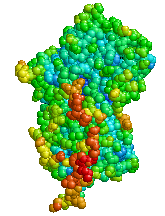
Photo from wikipedia
BACKGROUND & AIMS Alpha-1 antitrypsin deficiency (AATD) is a genetic disorder causing pulmonary and liver disease. The PiZ mutation in AAT (SERPINA1) results in mis-folded AAT protein (Z-AAT) accumulating in… Click to show full abstract
BACKGROUND & AIMS Alpha-1 antitrypsin deficiency (AATD) is a genetic disorder causing pulmonary and liver disease. The PiZ mutation in AAT (SERPINA1) results in mis-folded AAT protein (Z-AAT) accumulating in hepatocytes, leading to fibrosis and cirrhosis. RNAi-based therapeutics silencing production of hepatic Z-AAT might benefit patients with AATD-associated liver disease. This study evaluated an RNAi therapeutic to silence production of AAT. METHODS Part A of this double-blind first-in-human study randomized 54 healthy volunteers (HVs) into single dose cohorts (two placebo: four active), receiving escalating doses of the investigational agent ARC-AAT from 0.38 to 8.0 mg/kg or placebo. Part B randomized 11 patients with PiZZ (homozygous for Z-AAT) genotype AATD, who received up to 4.0 mg/kg of ARC-AAT or placebo. Patients with baseline FibroScan® >11 kPa or forced expiratory volume in one second (FEV1) <60% were excluded. Assessments included safety, pharmacokinetics, and change in serum AAT concentrations. RESULTS A total of 36 HVs received ARC-AAT and 18 received placebo (part A). Seven PiZZ individuals received ARC-AAT and four received placebo (part B). A dose response in serum AAT reduction was observed at doses ≥4 mg/kg with similar relative reductions in PiZZ patients and HVs at 4 mg/kg and a maximum reduction of 76.1% (HVs) vs. 78.8% (PiZZ) at this dose. The time it took for serum AAT to return to baseline was similar for HV and PiZZ. There were no notable differences between HV and PiZZ safety parameters. The study was terminated early because of toxicity findings related to the delivery vehicle (ARC-EX1) seen in a non-human primate study. CONCLUSION PiZZ patients and HVs responded similarly to ARC-AAT. Deep and durable knockdown of hepatic AAT production based on observed reduction in serum AAT concentrations was demonstrated. LAY SUMMARY Accumulation of abnormal proteins in the livers of patients with alpha-1 antitrypsin deficiency may lead to decreased liver function and potentially liver failure. Therapeutics targeting the production of these abnormal proteins may be used to prevent or treat liver disease in patients with alpha-1 antitrypsin deficiency. CLINICAL TRIAL REGISTRATION NUMBER NCT02363946.
Journal Title: Journal of hepatology
Year Published: 2018
Link to full text (if available)
Share on Social Media: Sign Up to like & get
recommendations!